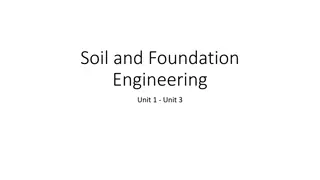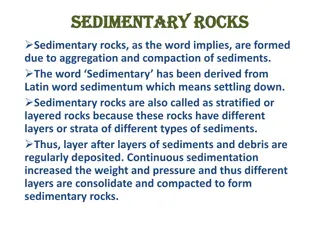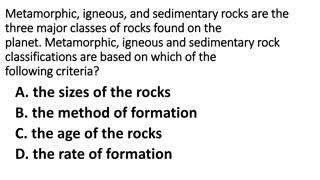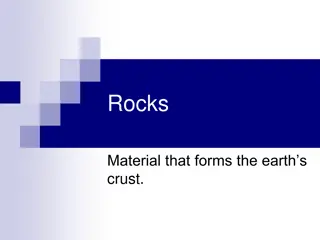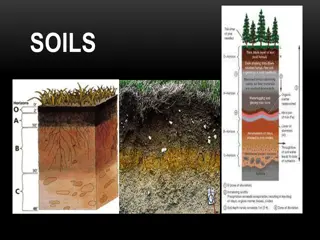Engineering Uses of Rocks in Civil Engineering - CE 260 Soil and Rock Mechanics
Rocks play crucial roles in civil engineering as building materials and foundations. Understanding rock properties such as strength and deformability is essential for assessing aggregate quality and ensuring proper structural support. Key properties include intact rock characteristics, discontinuities like faults and joints, and strength parameters like compressive, tensile, and shear strengths. Rock Quality Designation (RQD) helps classify rock mass quality based on the extent of fractures. Rock testing is vital for determining physical and mechanical properties for engineering purposes.
Download Presentation

Please find below an Image/Link to download the presentation.
The content on the website is provided AS IS for your information and personal use only. It may not be sold, licensed, or shared on other websites without obtaining consent from the author.If you encounter any issues during the download, it is possible that the publisher has removed the file from their server.
You are allowed to download the files provided on this website for personal or commercial use, subject to the condition that they are used lawfully. All files are the property of their respective owners.
The content on the website is provided AS IS for your information and personal use only. It may not be sold, licensed, or shared on other websites without obtaining consent from the author.
E N D
Presentation Transcript
Civil Engineering Department College of Engineering Course: Soil and Rock Mechanics (CE 260) Lecturer: Dr. Frederick Owusu-Nimo
Introduction Engineering Uses of Rocks: Rocks are used for engineering purposes in two primary ways: o As a building material : aggregates, cut stones, decorative panels, etc. o As a foundation : bedrock determines kind of structure that can be built. Knowledge and understanding of basic rock properties will o Enable us assess the usefulness and quality of aggregates o allow structures to be founded correctly so the required support will be there
Properties of Rocks The most important properties of rocks are those related to its strength and deformability Intact Rock: They are rock containing no significant fractures Discontinuities : These are faults and joints found in insitu rock. These may be weak links in the rock mass and may cause failures
Properties of Rocks The strength of rocks is the maximum stress it can sustain under a given set of conditions o Uniaxial Compressive Strength: It is stress which will cause a cylindrical rock sample to fail when it is subjected to two opposing (compressing forces). o Tensile Strength: It is stress which will cause a cylindrical rock sample to fail when it is subjected to two opposing (outward forces). Tensile strength of rocks is usually much lower than compressive strength o Shear Strength: It is the shear stress that acts on the plane of failure when rock is subjected to compressive or tensile forces
Properties of Rock Strength of rock mass depends on the extent of discontinuities (fractures) within it Rock Quality Designation (RQD): It is used to quantify degree of fracturing or discontinuities in the original rock mass. RQD is obtained by measuring intact fragments length of core pieces obtained from drilling RQD ???? ????? ? 10?? ???? ??? (???? ???) ????? 100 ??? = RQD gives an idea of the rock mass quality Values of RQD > 70% generally indicate sound rock
Properties of Rock Rock Mass Classification based on RQD RQD (%) Description of Rock Quality 90 100 75 90 50 75 25 50 0 - 25 Excellent Good Fair Poor Very poor
Rock Testing Rocks are tested to determine their physical and mechanical properties Tests may be used to provide information for classification purposes or for engineering design purposes Test for classification is used to group rocks of similar behavior and provide information on their geomechanical characteristics Test for engineering design purposes is used to provide detailed information on insitu stresses, rockmass strength and deformation properties
Rock Testing Laboratory Test: Conducted on small rock samples taken from the field site ( Rock Properties ) Field test : Conducted at the field site to determine the bulk strength properties of rock mass ( Rock mass properties ). These properties are influenced by the discontinuities or planes of weakness present in the rock mass Mechanical properties of an intact rock sample may be much different from that of the rock mass from which sample was obtained.
Rock Testing Laboratory Testing For Classification Purposes For Engineering Design Purposes Density Moisture content Porosity Water absorption Direct Shear test Uniaxial Compressive Test Triaxial Compressive Test Deformation characteristics
Rock Testing Field Testing For Classification Purposes For Engineering Design Purposes Discontinuity orientation Spacing Core recovery Rock Quality Designation Point load test Direct Shear test Field Permability In Situ Rock Stress determination
Rock Materials Reasons for laboratory Testing of Rocks Materials (Aggregates) o To assess the usefulness and quality of a new source of aggregate (quarry site) o Compare quality of rock materials from different sources o Predict performance in service o Predict durability
Rock Materials Various Laboratory Testing of aggregates: To evaluate how aggregates will perform when in service o Aggregate crushing value Test o The Ten Percent Fines Value Test Determine resistance of aggregates to crushing when subjected to loading o Aggregate impact value Test o Los Angeles abrasion test Used to indicate the toughness and abrasion characteristics of aggregates
Effect of water on Strength of Rocks Presence of water can significantly reduce rock strength in two ways o Water interrupts the bonding between minerals and allows the break up of clay cement leading to a reduction in rock strength and increased deformability o Water in joints may induce pore water pressure which acts in opposition to compressive stress, thus reducing effective normal stress between the rock surface. Water greatly reduces strength of porous sedimentary rock but have minimal effect on intact rock with low porosity


